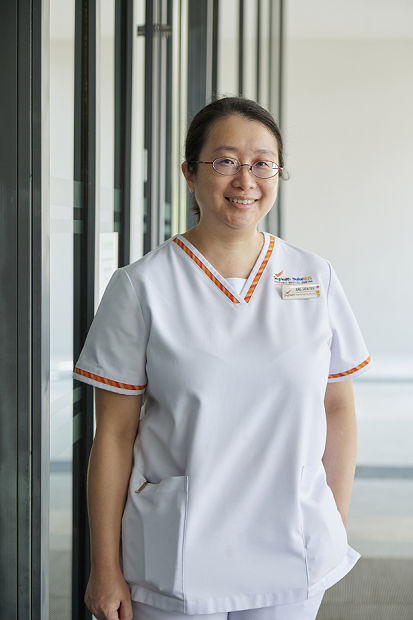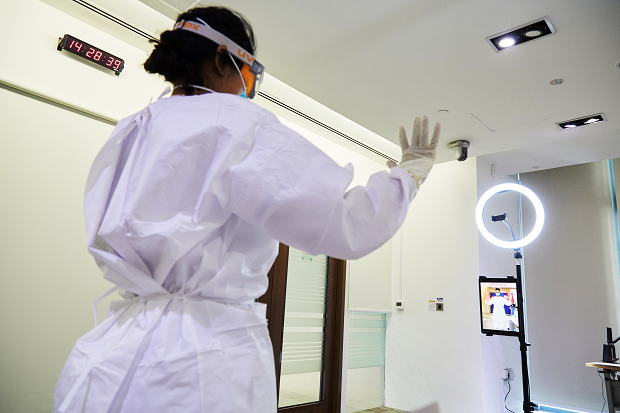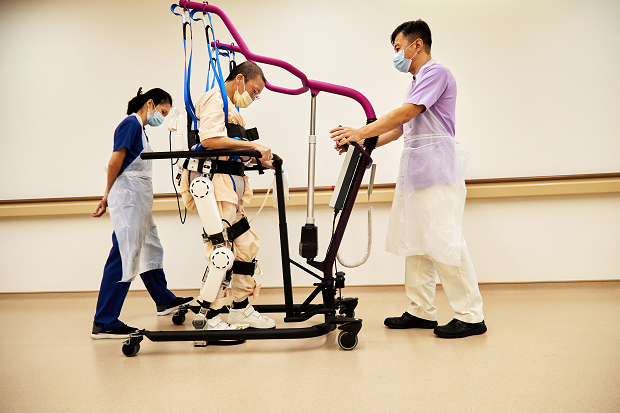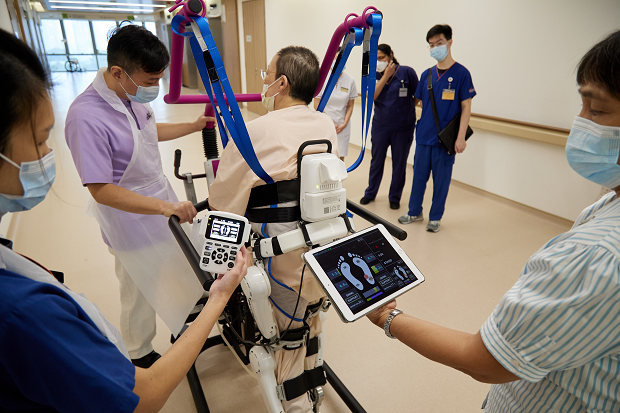Singapore General Hospital is harnessing the power of AI and robotics to enhance care by freeing staff from the more tedious and strenuous aspects of work.
A digital tool is teaching the correct way of wearing protective gear, while a smart harness strapped to a patient with walking issues is enhancing rehabilitation.
Respectively known as Blue Mirror Personal Protection Equipment (PPE) Instructor and Hybrid Assistive Limb (HAL), they are two recent additions to the range of intelligent devices and technology being deployed at Singapore General Hospital (SGH) as it faces the challenges of an ageing population and staff shortage.
The machines also highlight how the hospital is constantly looking for ways to adapt commercially available technology to take over the more tedious, strenuous and repetitive aspects of work. Doing so allows its staff to focus more on providing better patient care.
Mirroring the right steps
When SGH nurses were deployed to the Community Care Facility at the Singapore Expo during the COVID-19 pandemic, donning their PPEs became a daily affair.
Before entering the halls to care for COVID-infected migrant workers, nurses and other staff had to don the full PPE — including the gown, gloves and mask — and check each other to ensure that safety requirements were met. As this took precious time, it soon became apparent that what was needed was a quicker, less labour-intensive, and more sustainable solution that did not compromise the safety of the nurses.

“This pushed us to think about automating the process using artificial intelligence (AI) and image recognition,” said Ms Ang Shin Yuh, Deputy Director, Nursing Division, SGH.
That led to the development of a new AI-powered digital tool called the Blue Mirror PPE Instructor. When installed on iPads or tablets, the tool acts as a digital mirror that instructs the user through audio prompts and pictorial guides on what to do when putting on and taking off their PPEs. If it detects that gowns and gloves have been worn incorrectly, the tool quickly alerts the user.

<< Users can select between three modes. The ‘buddy mode’ is for healthcare workers who are already PPE-trained, and takes less than three minutes. It serves as a quick check to assure staff that they are gowned up safely before entering a patient’s room. The ‘training mode’ is meant for new staff and individuals who do not use PPE on a regular basis. It provides one-on-one sessions, allowing the staff to practise unlimited times without the need for a human trainer. For non-healthcare workers, the ‘visitor mode’ operates at a slower pace, with step-by-step instructions. Users may also select between four languages — English, Mandarin, Malay and Tamil. >>
“A nurse instructor
takes about 15 minutes to assess the competency of each new staff in donning and doffing the PPE. It can easily take half a day to train 15 new staff. With the Blue Mirror technology, the nurse can focus on patient care or perform other duties,” said Ms Ang, adding that the person need not be supervised and can practise by himself as many times as he likes.
Adopting and customising
Ms Ang mooted the idea to automate the PPE-checking process in 2020. SGH’s Nursing Division took the lead on the project. In November 2021, the hospital partnered New Zealand-based health tech company, Blue Mirror.
“The original Blue Mirror tool had to be customised for local needs and tailored to suit the hospital’s needs, including the types of PPE used,” said Ms Ang. The local version also improved the tool’s accuracy in detecting wrong movements during PPE removal, and the ability to detect surgical masks with visors.
The tool, validated by about 200 staff and visitors, has been deployed in the isolation ward, a multidrug-resistant organism ward, and SGH’s training department. “The tool can be further customised for disease-specific protocol, contact-tracing purposes and image recognition for staff access. This will put us in a better position should another outbreak occur,” said Ms Ang.
Exoskeleton trains gait
SGH started using machines in physiotherapy as far back as January 2013, with earlier gait-training systems. Today, a similar rehabilitation device using more advanced technology, known as the Hybrid Assistive Limb or HAL® Exoskeleton, is being used to rehabilitate patients with reduced muscle strength, impaired coordination, or other mobility issues because of stroke, brain tumours, or spinal cord injuries. When worn by the patient, HAL helps with standing and walking.
“HAL is able to pick up muscle activity from the patients’ legs to augment their movements, thus helping patients who have weak muscle strength in their legs,” said Ms Amanda Lee, Senior Physiotherapist, Department of Physiotherapy, SGH.
When someone intends to move, the brain sends signals via the spinal cord and the nerve cells to the muscles needed for the intended movement. As the signals travel towards the muscles, some ‘leak’ onto the skin. Even in those with disabilities, these very faint bio-electric signals can be detected.
HAL uses electrodes taped to the body to detect the signals, then determines the desired movements to help the patient move. Once strapped into the HAL exoskeleton, the patient becomes almost like a cyborg!

<< Without HAL, patients may need one or two therapists to support them. Strapped to the exoskeleton, the patient is able to walk on her own. This allows the physiotherapist to check how well the patient is progressing. The Physiotherapy Department is planning to train its therapy assistants to help patients practise their gait with the HAL without the presence of physiotherapists. >>
Used on a trial basis by SGH physiotherapists since April 2020, HAL is being offered to select patients undergoing conventional physiotherapy. So far, early feedback has been positive, with most of the 40 patients who have used it showing improvements in their walking ability.
Anecdotally, some have been observed to begin walking earlier, some with less assistance — with or without an aid — and some have been able to walk longer distances more quickly.
One stroke patient who started on HAL was unable to walk when he first started. While the exoskeleton held him upright to allow him to move his legs, he tended to buckle with each step taken, Ms Lee said. After his 11th session a week later, he did not buckle as much, and was able to swing his legs more easily. He subsequently was able to stand with the help of a cane. “We felt very motivated seeing his progress, as did the patient himself,” said Ms Lee.

<< Fewer staff are needed when a patient is using the exoskeleton, which supports the patient and takes over the heavy work done by physiotherapists and assistants in conventional therapy.>>
Less physical stress on staff
“HAL makes it possible to increase the repetition, frequency and guidance compared with conventional therapy, where physiotherapists don’t have as much time to spend with each patient,” said Professor Celia Tan, Senior Director, Special Projects, DGCEO (Medical and Clinical Services) Office, SingHealth.
Patients with mobility issues often need to be held or supported manually during therapy, which also puts physical stress on the therapists and assistants. HAL does not need the patient to be manually supported, so patients can practise walking on their own, taking more steps, and at their own convenience. “We recognise the importance of incorporating equipment into our therapy sessions to maximise the patient’s ability to perform the desired movements while ensuring staff’s safety when assisting the patients to move,” said Ms Lee.
Patients with neurological disorders need intensive, demanding and varied therapy to help them regain their lost functions. Repeating their exercises can also help reinforce and promote motor learning. Compared to the earlier gait-training machine, for instance, HAL is generally much easier to wear and take off. HAL also allows patients to practise walking on the ground, replicating their real life experience, while patients walk on a treadmill with the earlier machine.
Nevertheless, even HAL is limited in its abilities compared to a human therapist. “At present, machines are not able to assess and identify the deficits in a patient’s movement, thus the physiotherapist’s input is still required,” said Ms Lee.
Get the latest updates about Singapore Health in your mailbox! Click here to subscribe.
